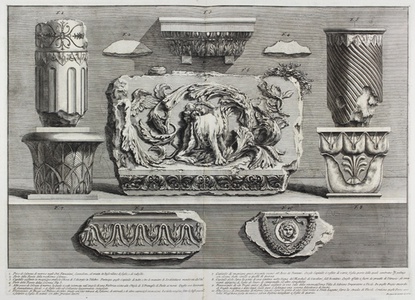| Method | Etching |
| Artist | Giovanni Battista Piranesi |
| Published | Piranesi Architetto dis. ed inc. [Rome, Bouchard, c.1753] |
| Dimensions | Image 435 x 600 mm, Plate 442 x 610 mm, Sheet 477 x 635 mm |
| Notes |
An illustration of various capitals, column pieces, and architectural fragments, from Piranesi's Trofei di Ottaviano Augusto. The ten diagrams on the sheet show a column fragment with basso relievo arabesques and leaf patterns from the Horti Farnese and a fragmentary cross-section of the same column, a column capital from the Church of St George in the Velabrum featuring an unusual pedimental pattern of acanthus and egg and dart, another column fragment with leaf patterns and spiral fluting from the Church of St Francis as well as another fragmentary cross-section, a column capital with vegetal decoration 'in the Greek manner' from the Arco dei Pantani (one of the two Tiberian triumphal arches by the Temple of Mars Ultor), another capital featuring laurel leaf patterns from the vineyard of the Marchese de'Cavalieri on the Aventine, a fragment of stucco freize in a floral pattern from Hadrian's Villa at Tivoli, and a marble ornamental fragment featuring a gorgoneion and an oak chaplet from the Ponte Lugano. Piranesi's first foray into archaeological survey was the short, but grandiosely titled, volume Trofei di Ottaviano Augusto innalzati per la Vittoria ad Actium e conquista dell'Egitto con vari altri ornamenti diligentemente ricavati dagli avanzi piu preziosi delle fabbriche antiche di Roma, utili a pittori, scultori ed architetti, designati ed incisi da Giambattista Piranesi, Architetto Veneziano. Taking as its inspiration the two antique trophies that had been set up on the terrace of the Campidoglio in 1590, Piranesi argued for an attribution to Augustus in commemoration of the Battle of Actium. The trophies, which had been rediscovered in an excavation of the fountainhead of the Aqua Julia, were colloquially known as the Trophies of Marius. Piranesi's pamplet contained detailed illustrations of the trophies, as well as a pair of general views and a series of plates depicting other architectural fragments that the artist believed would be of interests to other antiquarians, sculptors, architects, and cognoscenti. Giovanni Battista (also Giambattista) Piranesi (1720 – 1778) was an Italian artist famous for his etchings of Rome and of fictitious and atmospheric "prisons" (the Carceri d'Invenzione). He was a major Italian printmaker, architect and antiquarian. The son of a Venetian master builder, he studied architecture and stage design, through which he became familiar with Illusionism. During the 1740's, when Rome was emerging as the centre of Neoclassicism, Piranesi began his lifelong obsession with the city's architecture. He was taught to etch by Giuseppe Vasi and this became the medium for which he was best known. Wilton-Ely 274, F139, C387 Condition: Strong clean impression. Central vertical fold as issued. Some splitting, discolouration, and creasing to central fold. Repaired tears to top and bottom of central fold. |
| Framing | unmounted |
| Price | £650.00 |
| Stock ID | 50555 |

